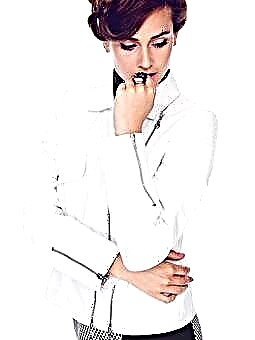There may be several reasons for this defect. Moreover, it is not immediately possible to determine exactly why the board at the bottom of the coat is wrapped in precisely in this particular case.

Consider the possible causes of this problem and list the ways to solve it.
Reason 1. Deviation from linear dimensions
This is possible if during the WTO or when duplicating the details of the side of the coat, you stretched the edge and, accordingly, deviated from a straight line.
What can be done
Put the coat on the table with the side to the very edge and see how the line of the side deviates from a straight line.
Sort the seam of the grind to the bend of the lapel.
And try to stick the edge of the board.
Then again chop the parts and grind.
Iron the seam.
Or:
Open the bottom, the cut of the side of the shelf will go beyond the cut of the shelf by the amount of inversion. Get the so-called "scissors".
It is necessary to tailor the extension to the pick-up to the height and taking into account the width of this twist, stitch it to the pick and grind the board again - in this case the sub-board will be composite.
The extension should not be shorter than 10 cm.
How to sew and sew parts from bulk fabrics
Reason 2
The details of the collar and bead or only the collar are not duplicated, and the bottom of the coat is not duplicated over the hem line. Especially in knitted fabrics for coats.
What can be done
Duplicate parts in accordance with the instructions.
Reason 3. Lining problem
The lining pulls: either it is improperly stitched to the selection, or the lining is already what it should be.
What can be done
Put on your coat, don’t fasten, stand in front of the mirror. Lightly spread the floor of the coat with your hands or see if there is any internal tension somewhere.
If there is a diagonal tension, then you need to slightly raise the lining, attach it along the seam of the seam by about 1 cm, maybe this will be enough.
If the lining is pulled in width, it is necessary to release the lining along the side seams as far as allowances allow.
Reason 4
The angle below the side and the pick is not straight.
What can be done
Align the corner at the bottom of the side and fit with a square.
How to avoid displacement of parts at the end of the seam
Reason 5
Failure to comply with the direction of the equity line during the layout and cutting of parts, as a result of which there was a skew.
What can be done
This is perhaps the most difficult situation in which you can try to do only one thing. Fully open the coat and redraw the details with the exact observance of the direction of the shared thread.
What is a shared thread and how to determine it
From personal experience
I faced a similar situation when I was sewing a coat of fabric on a knitted basis.After connecting the coat with the lining, I tried on the fitting that the right side of the coat below is wrapped inward.

The right side of the coat is wrapped inward

Top view from the wrong side
I managed to fix this defect as follows:
✂ Put the coat on the table side to the edge.

✂ Determined how far the side line deviates from the straight line.
✂ Tailor's chalk (you can use tailor pins) noted this difference.
✂ The seam of the stitching of the pick was torn to the fold of the lapel.
✂ Sutyuzhila edge of the starboard side at the point of inversion.
✂ Then compared it with a paper pattern, it turned out that there was a slight discrepancy - the starboard side was more by 0.5 and 1 cm (from the edge to the bottom) compared to the left side.

✂ I fixed this defect with a square and scissors.
✂ Again chopped board with a pick, tried on and rocked.

✂ Sewed a seam and ironed it.
Advice:
► When turning the sides, the easiest way to control the evenness of lines is along the edge of the table.
► In order not to stretch the coats and sections of parts, iron and iron with walking movements.
Perhaps, even after all the manipulations performed, the defect will not go away completely, but it will certainly become less noticeable.
The author of the master class and photo: Julia Dekanova



